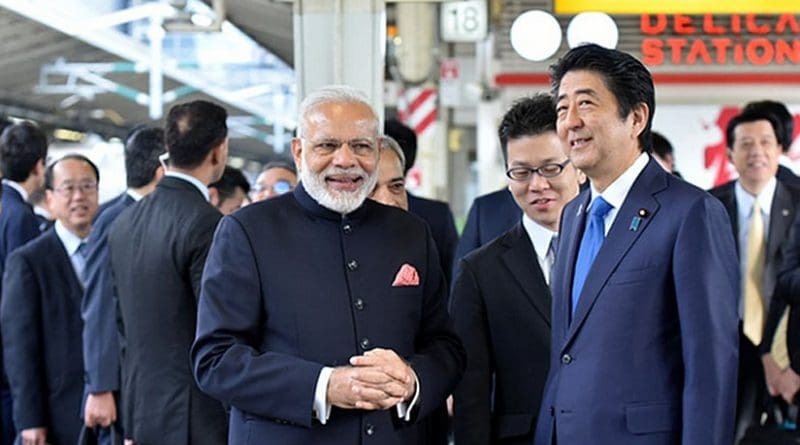Dynamism In Indo-Japan Relations Add Fresh Worries To Chinese OBOR – Analysis
The new dimension of Indo-Japan relation to global partnership and defence cooperation ignites new concern for China, after it was let down by the Doklam stand-off. China suspects the India-Japan partnership for Asia-Africa-Growth-Corridor project ( AAGR) is a ruse and has deciphered it as an attempt to counterbalance to China’s OBOR (One Belt One Road), displaying the fear of double standard of the aim.
Eventually, AAGR will overlap the OBOR route geographically. The Global Times – a English version of China’s official media – jeered at the connectivity, saying “ AACG – connectivity project jointly forged by India and Japan — is an oppositional vision intended to counterbalance China’s Belt and Road initiative”. It threatened the connectivity will backfire since China has made a huge commitment to develop Africa and India is at the pre-natal stage.
Sino–Japan relations are deteriorating and Sino-India relation are not palatable either. Against these backdrops, a new dimension in India-Japan relations is being eyed by a wary China with regard to its prestigious OBOR project. Neither Japan, nor India, are members of OBOR.
India–Japan relations are in the throes of new dynamism with a paradigm shift from a bare bilateral trade and investment link to special strategic and global partnership. It extended to joint partnership for economic development of third countries and defence cooperation. Development of AAGR project, joint cooperation for development of Chabahar Port in Iran, strengthening of defence cooperation for national security with Memorandum of Understanding on Defence cooperation and Exchanges and two Defence Framework agreements exhibit the dynamism of the relation in global partnership and defence coopearation.
The new dimension of India-Japan relations are polarized on three pillars. First, is High Speed Railway, with the setting up of first Bullet Train in the country connecting Mumbai and Ahmedabad. Second, security and defence cooperation through various exercises, such as trilateral Malabar drills with India-Japan-USA and a reiteration of commitment for the maintenance of peace in South China sea.
Third, joint cooperation with Japanese technical know-how to manufacture US-2 aircraft in India, in addition to import the US-2 amphibian aircraft from Japan.
The Prime Minster of India, Mr Modi, is trying to re-write a new chapter in India- Japan relations with a shift from a strategic economic relation to a global partnership. He reiterated that India and Japan were the two oldest democracies in Asia and were among the three biggest economies. He asserted that 21st Century is to be decided by Asian countries and India and Japan bilateral relation would be the engine for 21st Century growth. Mr. Modi is one of the three twitters that Mr Shinzo Abe follows. The commentators have hailed Modi as “India’s Abe.”
Japan is the third biggest foreign investor in India. Decrying the Japanese investment surge, Chinese media, Global Times said, “Japan can’t replace products from China in India ‘s low income consumer market”.
Paradoxically, last year Japanese investment in India spurred and 110 Japanese apparel firms in China went bankrupt, leading to a dip in Japanese investment in China.
The Chinese rant on Abe’s upcoming visit that “sweet words won’t bring real money” is dissipated with by increase in Japanese investment in India.
Even though 110 Japanese apparel companies pulled down their shutters of garment manufacturing and shifted to Vietnam and Myanmar to offset high cost manufacturing in China, implying that these two nations are most cost effective manufacturing destinations for Japanese investors. But, these shifts do not epitomize the two Asian nations having edge over India in low cost manufacturing competitiveness in all sectors
In 2015, Toshiba and Panasonic announced that they would stop producing television sets in China. These reflected the Japanese frustrations in China and underscored the trend of Japanese exit from the country.
“Any loss to China is a gain to India” is a new catchphrase. India poses potent to alternative destination for low cost manufacturing. According to a Deloitte survey in 2016, India will be the “New China” in low cost manufacturing countries in next five years. India will rise to 5th rank in the global manufacturing competitiveness index in 2020 from 11th position in 2016, the survey said. With China losing the powerhouse of low cost manufacturing competitiveness, five Asia Pacific nations will emerge the choice for low cost manufacturing destinations in place of China. They are Malaysia , Thailand, Indonesia, Vietnam and India. India will be the front-runner, the survey said.
Evidently, while Japanese investment in major Asian nations witnessed a downturn, investment in India surged. In between 2014 and 2016, Japanese investment in China , Hong Kong and Thailand fell – by 21 percent, 36 percent and 27 percent respectively. On the contrary, Japanese investment in India surged. In between 2014 to 2016, Japanese investment in India rose by 53 percent. Besides foreign direct investment, Japanese deployed huge amount of investment in private equity and venture capital in India. During the first half of 2017, Japanese firms invested at least US $1.43 billion in Indian private equity and venture capital. This was three times more than US $459 million in 2016, according to a Japanese media, Japan Times.
Thus, the contagion impact of China’s let down in Doklam stand-off and dynamism of Indo-Japan relation will act double whammy to China’s political and economic influence in Asia region through OBOR.
Views are personal

